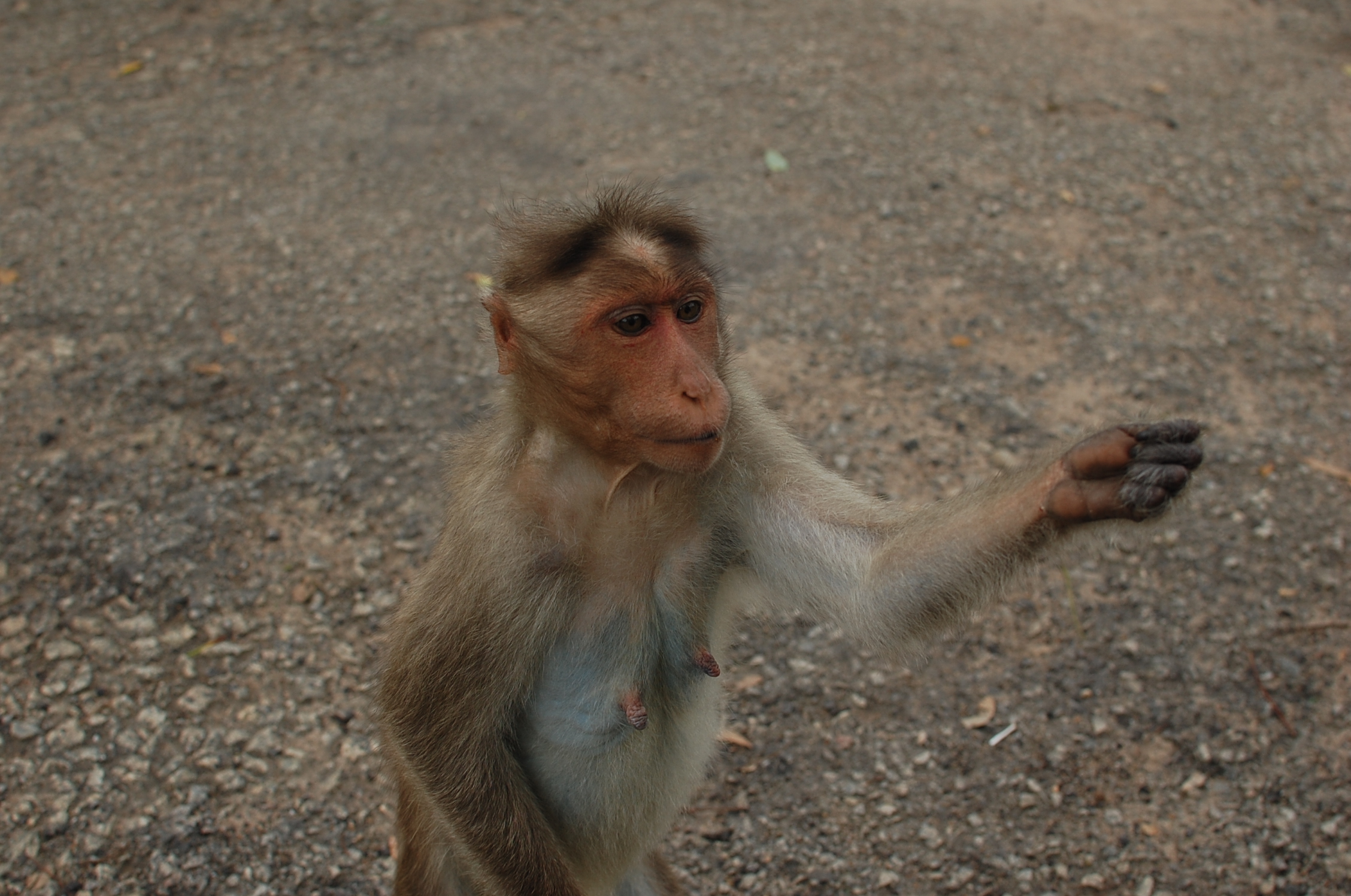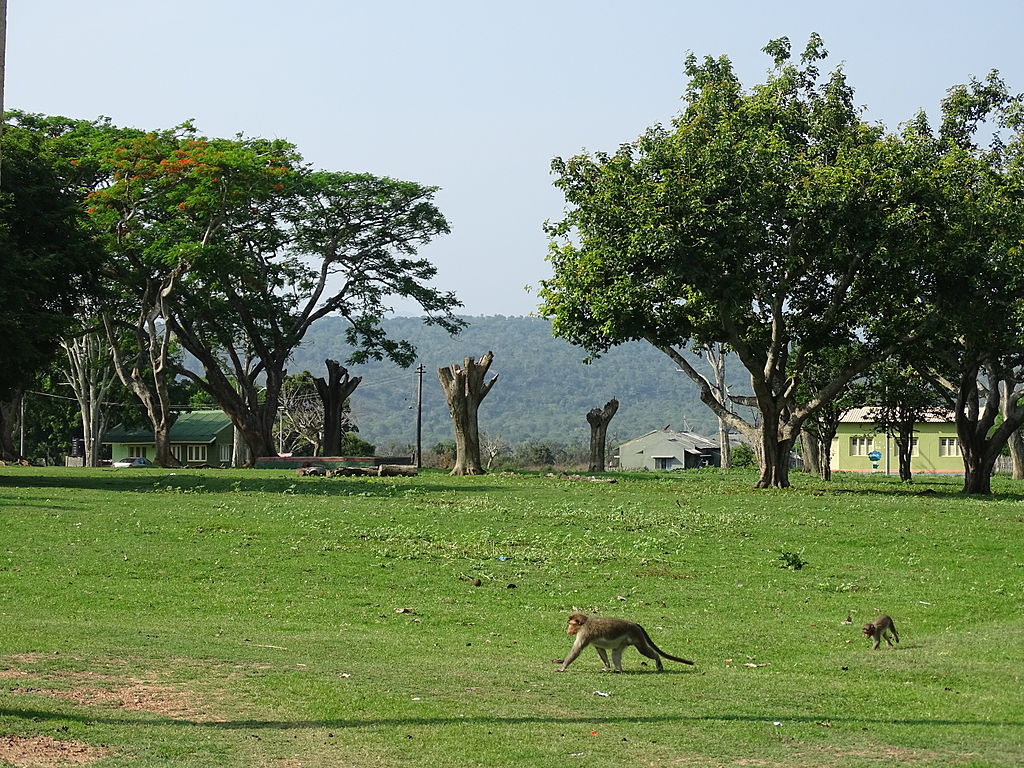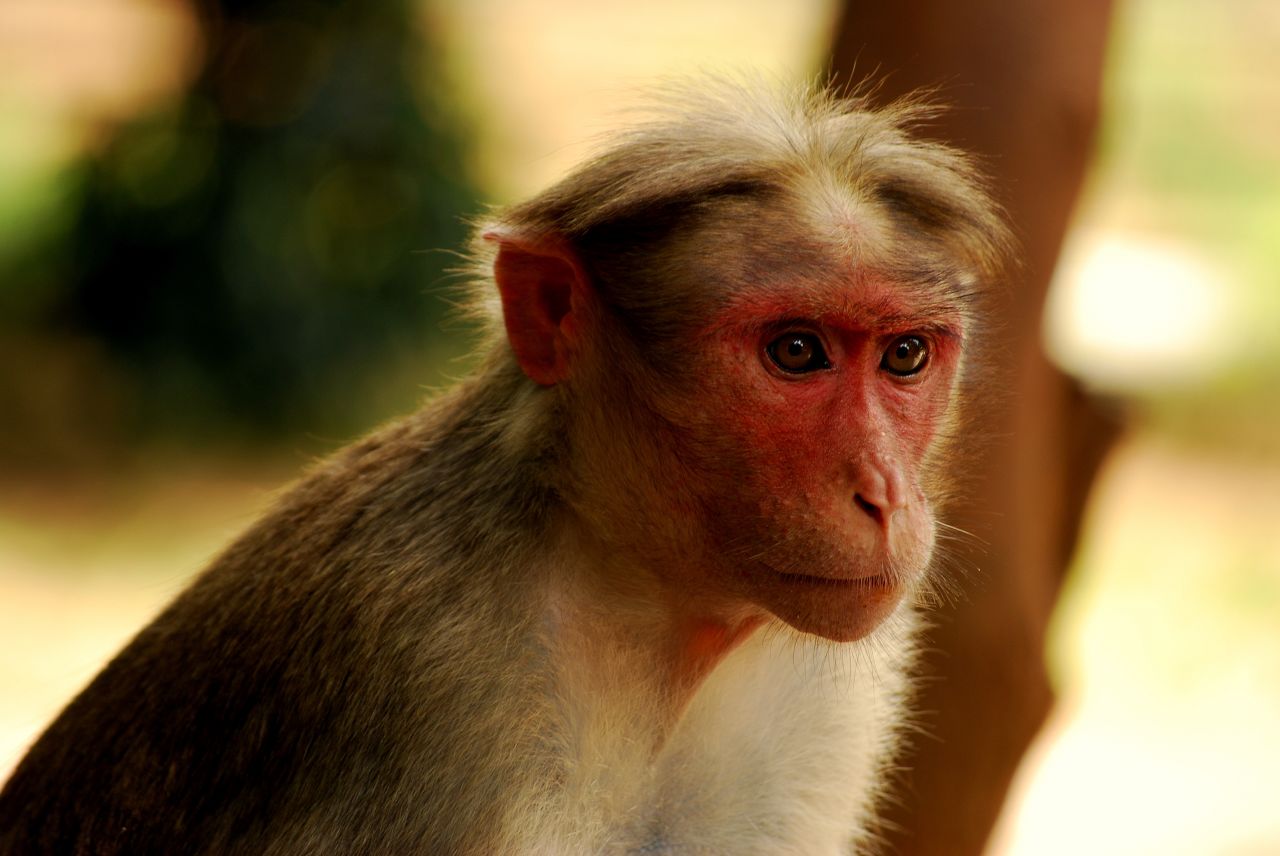- Young bonnet macaques at Bandipur Tiger Reserve have evolved a novel strategy to obtain food from visiting tourists. While adults threaten visitors or snatch food, young macaques make eye contact and extend their hand in a ‘begging’ gesture.
- The monkeys also make a soft coo call, orient their bodies to the target human’s field of vision and monitor the individual carefully until they get their food or get chased. They show the food requesting behaviours only to tourists carrying food.
- The ability of young macaques to pick a suitable target (a human with food) and assess the attention state of the target human, and modify their behaviour accordingly, makes this behaviour a case of ‘intentional communication’. This study is the first to document intentional communication in a non-ape primate species in the wild.
The visitor information centre at Bandipur Tiger Reserve is often a stage for a lot of monkey-human drama, with two troupes of bonnet macaques jostling with thronging tourists. Adult monkeys take centre stage, using a direct approach to get at food — they simply scare humans into giving up their food.
Younger monkeys on the sidelines take a different approach. They try to make eye contact with a human carrying food, and when their eyes meet, the monkey extends its hand, palm up, as if to receive food. This food requesting behaviour is sometimes punctuated with a soft coo call, and if needed the monkey orients its body to remain in the human’s field of vision, to draw attention to itself.
“The hand-extension gesture is a completely novel gesture for wild monkeys. Certain macaque individuals have been seen to show this gesture towards human caregivers [in captivity] but it has never before been seen in a wild monkey and used in a natural context,” said Anindya Sinha, professor at the National Institute of Advanced Studies and senior author of the study reporting the behaviour. “In that sense, it is definitely a new gesture.”

Over a period of four months, Adwait Deshpande and Shreejata Gupta from Sinha’s research group watched the two troops of bonnet macaques (Macaca radiata) that reside at the reception area in Bandipur National Park. Focussing on the larger, more dominant troop, which interacted with people a lot more and displayed these behaviours more frequently, he managed to record 86 natural ‘chats’ between macaques and tourists.
A mix of multiple signals
The authors have teased apart the food requesting behaviour into four components. First, the hand extension gesture, which is being documented for the first time in a wild monkey species.
Second, a soft coo call for which the researchers could not assign a clear purpose. The monkeys produced the sound when humans approached carrying food, and the researchers speculate that the call could be to establish contact with a human target, to convey intent to the human, or talk to itself to maintain motivation.
The researchers also observed that these two key behavioural components, the coo call and hand extension gesture, were only used by the Bandipur bonnets when interacting with humans. Specifically, humans carrying food!
The third component is orientation behaviour, where the macaques oriented themselves to stay in the humans’ field of vision, to attract attention. The fourth component is audience monitoring — the monkeys kept watching the human target while requesting food, and stopped only after they got the food.

Only juvenile bonnet macaques showed this food requesting behaviour, never adults. Adults just snatched food from tourists or scared the tourists by threatening aggressively, observed the authors. What the juveniles were showing in this behaviour was not aggression, but “a sort of begging behaviour, which is highly unusual in bonnet macaques”, write the authors in the paper.
They surmise that the juveniles are using this behaviour as a strategy to supplement their food. They are competing with adult macaques for the same resources; being smaller and generally more afraid of humans, they have evolved a different plan of action.
There is variation even within a troop — not all juveniles showed food requesting behaviour. “One of the reasons — though we haven’t studied this formally — could be personality differences. When we do our studies we find some individuals tend to be more tolerant to us, they will approach and try to groom us; some are shy; yet others are very aggressive, even from a distance they will keep threatening us,” said Sinha in an interview with Mongabay-India. “Those who are more comfortable with people tend to show this behaviour more than others.”
The researchers also conducted field experiments on four juvenile macaques, to check whether the attentive state of the humans having contact was necessary to get a behavioural response. During the experiments, trained volunteers approached the test macaques with food in their hands, maintaining eye contact, or not. [Note: no macaques were fed during the course of these experiments.]
Both from the natural observations and field experiments, it was evident that macaques performed the hand extension behaviour more frequently when there was eye contact.
“The coo call was done even when macaques were following the human being, irrespective of whether the person with food looked at the macaque or looked away,” said Sinha. “On the other hand, the hand extension gesture would appear only when the person was looking at an animal.”
The flexible use of these behavioural components by the bonnet macaques “illustrates the inherent capacity of bonnet macaques, to develop and employ novel behavioural strategies, reaffirming the remarkable behavioural flexibility and the adaptive cognitive abilities of this species,” write the authors in the press release.

Charlotte Canteloup from the University of Lausanne, who was not involved in the study, agreed. “Developing such flexibility in the communication allows animals to communicate more efficiently and [in this case] to maximise their food intake. Macaques are in competition for food with [other macaques], and they probably learned from past interactions with humans that they can have food from them, and have developed such interspecific communication.”
Why these particular signals?
The coo call is used by bonnet macaques as a form of communication between them, but has never been reported as a mode of communication with humans outside captive conditions, write the authors in the paper.
“Soft coo calls are known from macaques, they have never been reported in bonnet macaques,” said Sinha. “The current form of the call may have been co-opted from the much-louder lost call that bonnet macaques often give when they are isolated from their troop. In that sense, it is a rather novel call for the species.”
“Whatever be the origin, they have co-opted this call to attract people,” added Sinha.
Regarding the hand extension gesture, Sinha said, “The monkeys are most probably reaching for the food they cannot get at otherwise, and it gets reinforced when someone gives them food. This behaviour is never used with each other within the same species because bonnet macaques do not share food.”
Why they started using this gesture to humans remains a mystery, and will probably remain a mystery. “Can it be that the macaques saw humans reach out for food with each other? We will never know,” said Sinha.

Sindhu Radhakrishna, a primate biologist at NIAS, said “maybe there is no need to think about the initial reasons for this behaviour. It could be as simple as ‘I did this and I got this’.”
“We can also examine monkey-human interactions from another angle. The authors have looked at the behaviour from the aspect of monkeys communicating with humans. But, the bonnets are also acting in a specific manner to elicit a particular response from humans,” she said. “A lot of us have encountered aggressive rhesus macaques and bonnet macaques in other areas. They have figured out that aggression works — humans get scared and drop their food. In this case, the young bonnet macaques have figured out that hand extension works.”
Why has the behaviour appeared in Bandipur?
“The reason the behaviour has ‘appeared’ in Bandipur, is because we were there,” said Sinha, laughing.
“After publishing this work, I’ve had people approach me saying they’ve seen macaques show this behaviour. It may be true across species, it may take on different forms — but nobody has bothered to document it,” he said.
Both Radhakrishna and Narayan Sharma, assistant Professor at Cotton College Guwahati, who studies primates in Northeast India, agree. “I guess such behaviours might be widespread but we need long-term and intense observations to record them,” said Sharma.
As part of a long-term animal behaviour project at Bandipur, Sinha’s group has been monitoring about 30 troops — consisting of about 1800 individuals — along the Mysore-Ooty Highway for the last 18 years. The researchers have seen either the coo call, or the hand extension, or both in five or six troops at different points in time.

Sinha has observed some components of this food requesting behaviour in bonnet macaques in other areas. The team saw both behaviours — the coo call and hand extension — expressed together for the first time in 2013. “By the time Adwait [Deshpande] joined the project and visited Bandipur in 2016, he could see about 17 or 18 juveniles using this complex behaviour, out of the 30 or so who were there,” said Sinha. “We haven’t really analysed the trajectory, but the behaviour spread fairly rapidly,” he added.
A precursor to language?
‘Intentional communication’ is the display of communication signals that are sensitive to the state of the receiver, involving the cognitive skills of assessing the attention state of the audience, and modifying the signal appropriately.
This ability is thought to be the forerunner of human language, and studying intentional communication in non-human primates (monkeys and apes) can provide us with a window to examine the origins of one of our most complex behaviours, human language.
The authors write that this study is the first (and as of now the only one) to document intentional communication using gestures in wild populations of a monkey species; most studies of this kind tend to focus on great apes. Earlier studies that document intentional communication in non-ape primate species like macaques, have all been in captivity.
Intentionality is described by four different criteria, and the authors have described how these behaviours satisfy these criteria by using an example we are all familiar with — going to a restaurant when hungry to get a snack.
Just as we would go to a particular restaurant and give our order to a waiter at a restaurant, the bonnets request food using the hand extension behaviour only from people holding a visible item of food in their hands; they do not show this behaviour in any other context. This is the first criteria of intentionality — a signal used for communication to a recipient is modified by various factors like the presence of food.
The second criterion is the sensitivity of the signaller to the attention state of the audience. At the restaurant, we need to get the attention of the waiter to give the order; the bonnets perform hand extension only when the target human is making eye contact.

At a restaurant, we sometimes walk up to the waiter to get him or her to notice you. This is the third criterion for intentionality — manipulating the attention of the recipient. Bonnets at Bandipur do this by orienting themselves in the line of vision of the human they are targeting.
The macaques also monitor the response of the target humans, like how we monitor the waiter at the restaurant, satisfying the fourth criterion of intentionality. Finally, the macaques only show the signals until they get the food item; just as we bother the waiter only until we get the food — this is the final criterion for intentional communication.
“I agree that the intentional communicative behaviours they recorded in wild bonnet macaques is one of the first instances of such behaviours recorded in a wild population, especially in monkeys,” said Canteloup. “Studies on intentionality of communication previously focused on great apes species, neglecting monkeys, it is then really interesting to find similar results in a [distantly related] species like the bonnet macaque.”
A non-ape primate has evolved a ‘behavioural innovation’ that has allowed them to survive in a novel environment created by humans. The communication signal is aimed at members of another species, and never toward other macaques. Macaques do not typically share food, they tend to hoard and guard.
“There is no way this behaviour would be rewarded if directed toward another macaque, so how did they arrive at this signal to show humans? We don’t know. One can imagine this behaviour getting positively reinforced and spreading among the troop, but why the first innovative individual raised his/her hand will always remain a mystery,” Sinha commented.
CITATION:
Deshpande, A., Gupta, S., & Sinha, A. (2018). Intentional communication between wild bonnet macaques and humans. Scientific reports, 8(1), 5147.
Note: Please do not feed bonnet macaques, or any other animals, in the wild. Many studies have shown that such ‘provisioning’ of wildlife can affect lifespan, social organisation in group living species like the macaque and increase aggression in the species. Note that the authors have not provided food to the macaques during these experiments.